Uncertainty Analysis in SAR Sea Surface Wind Speed Retrieval through C-Band Geophysical Model Functions Inversion
Abstract
:1. Introduction
2. Datasets
2.1. SAR Data
2.2. NWP Model Data
3. Methods
3.1. Estimation Methodology for SAR SSW Speed and Its Uncertainty
- The uncertainties Δσ0, Δθ and Δφ. The two former are evaluated within each ROI as the standard deviation of the calibrated SAR backscatter (i.e., Δσ0 = STD(σ0ROI)) and the SAR incidence angle (i.e., Δθ = STD(θROI)), whereas the corresponding mean values are given by σ0 and θ, respectively. The latter uncertainty is instead represented by the error associated with the SSW direction φ, both estimated for the same ROI. The directional estimate βROI (i.e., φ = βROI) and the marginal error MEαROI (i.e., Δφ = MEαROI) are provided by the MS LG-Mod method, as described in [40].
- The average values σ0, θ and the mean directional estimate φ. They are assumed as the true values of the corresponding parameters within the ROI, with σ0 = MEAN(σ0ROI), θ = MEAN(θROI) and φ = DIRMEAN(φROI), respectively. The operator DIRMEAN computes the directional mean, thus assuming that directions φROI must be considered as axial data in the ROI [40]. The triplet (σ0,θ,φ) represents the ‘true state’ for which the corresponding SAR SSW speed uncertainty is considered to be null.
- The specific GMF used to model the SAR sigma nought as a function of the SSW speed and direction, the SAR geometry, frequency and transmitting-receiving polarizations.
- The cost function J adopted for the minimization procedures. Without limiting the generality of the foregoing, a square function was chosen for this study as expressed by (2) and (3).
- The approximation error for SAR SSW speed retrievals. In this work, the inversion procedure provides wind speed values in the range [0, 35] m/s with an approximation error of 0.1 m/s. The latter represents the step used in the iterative procedure to minimise the cost function.
3.2. Comparison Procedure
4. Results and Discussion
4.1. Statistics of SAR-Derived Parameters
4.1.1. SAR NRCS, Incidence Angle and SSW Relative Direction
- The MS LG-Mod SSW relative direction, expressed in the range [0°, 360°], is on average about 184°, with a small variation (growing) of standard deviation depending on the examined ROI dimension. This means that the visual selection of the S-1 regions characterised by clearly visible wind rows yielded to this prevailing wind direction. This fact confirms that, according to [44], wind rows detection depends strongly on the azimuth angle, with patterns detection rates at crosswind (φ = 90°/270°) being much lower (i.e., 3–10 times) than for upwind (φ = 0°) or downwind (φ = 180°). As regards the uncertainty associated with the SSW relative direction (by the MS LG-Mod), both the precision and the accuracy are decreasing (improving) with an increasing ROI dimension, ranging from 12.08° (at 5 km) to 4.16° (at 15 km) and from 5.56° (at 5 km) to 1.52° (at 15 km), respectively. As expected, a greater ROI size allows a better directional estimation of the wind, due to a higher number of usable points for the estimation within such dimension ROI [40].
- The incidence angle is quite stable around the average value of about 37.3°, with a small standard deviation which is basically independent from the ROI dimension. Hence, wind rows are most commonly observed at higher incidence angles in the available dataset, thus confirming again [44]. The uncertainty associated with the incidence angle increases (worsens) with an increasing ROI dimension in terms of both mean and standard deviation, ranging from 0.09° (at 5 km) to 0.27° (at 15 km) and from 0.01° (at 5 km) to 0.02° (at 15 km), respectively.
- The NRCS is about 0.1022 with a standard deviation of about 0.0526, considering the three different ROIs dimensions adopted for processing. The uncertainty of the NRCS slightly increases (worsens) with an increasing ROI dimension in terms of mean and standard deviation, varying from 0.0056 (at 5 km) to 0.0063 (at 15 km), and from 0.0029 (at 5 km) to 0.0035 (at 15 km), respectively.
4.1.2. SAR SSW Speed and Its Uncertainty
- For each ROI size adopted, the two applied GMFs produce similar statistics, with an absolute difference of the mean and standard deviation of SSW speed of about 0.5 m/s and 0.3 m/s, respectively, and an absolute difference of the mean and standard deviation of the related uncertainty of about 0.1 m/s and 0.03 m/s or less, respectively. All statistics obtained from the CMOD7 are smaller than those from the CMOD5.N. It appears that the CMOD7 allows better precision and accuracy in the estimation of SSW speed and its uncertainty. This is in accordance with the fact that the CMOD7 represents an improvement of the CMOD5.N in general, and especially at low winds [46].
- For each GMF applied, the mean (about 15.24 m/s and 14.77 m/s for CMOD5.N and CMOD7, respectively) and the standard deviation (about 3.53 m/s and 3.25 m/s for CMOD5.N and CMOD7, respectively) of SSW speed are quite independent from the ROI dimension. On the contrary, the mean and the standard deviation of SSW speed uncertainty significantly depend on the ROI size. In fact, the greater the ROI dimension, the lower the estimation statistics (i.e., between 2.07 m/s and 1.35 m/s for the mean, and 1.12 m/s and 0.58 m/s for the standard deviation, in the case of CMOD5.N; between 1.97 m/s and 1.26 m/s for the mean, and 1.11 m/s and 0.56 m/s for the standard deviation, in the case of CMOD7).
4.2. Contribution of Different Parameters to SAR SSW Speed Uncertainty
SAR Dataset Results
- For each ROI size adopted, the CMOD5.N and the CMOD7 produce a similar ratio, for both mean and standard deviation, and for each contribution (i.e., E1, E2 and E3).
- For each GMF applied, the ratio of both mean and standard deviation for each contribution depends on the ROI dimension. In particular, focusing on the ratio of the mean values, with an increasing ROI dimension, both the contributions E1 and E2, strictly due to the NRCS (Δσ0) and the incidence angle (Δθ) uncertainty, respectively, increases; on the other hand, the contribution E3, strictly due to the MS LG-Mod SSW relative direction uncertainty (Δφ), decreases. For example (Table 3), for our S-1 dataset, the results for the CMOD7 application show that the contribution E1 varies from 34.5% (at 5 km) to 51.0% (at 15 km), the contribution E2 changes from 6.9% (at 5 km) to 22.3% (at 15 km), and the contribution E3 decreases from 59.9% (at 5 km) to 29.2% (at 15 km).
4.3. Assessment of SAR SSW Direction and Speed Uncertainty as Proxy of Accuracy
- Although ERA5 wind data are gathered in this work in “open water” condition and assumed as reference for comparisons, these global NWP model data are doubtless affected by their own uncertainties, e.g., with a wind speed RMSE ranging from 1.25 to 1.5 m/s in the Dutch North Sea [47].
- SSW direction and the related uncertainty are provided by the MS LG-Mod algorithm as a directional mean and a measure of the directional content within each WVC [40]. However, the directionality of patterns in a cell may be sometimes affected by other local phenomena, even after a careful human eye selection of regions characterised by wind rows. In addition, as well known, the direction extracted by wind rows is not exactly aligned to the actual local wind direction [33], also depending on the phenomena causing the wind rows themselves.
- NRCS value and its uncertainty are assumed to be given by the mean and standard deviation of the NRCS in the WVC. It has been shown that the distribution of NRCS values is an important factor which can influence the accuracy of SAR wind and that should be taken into account [48]. Nevertheless, the sigma nought signal in the cell may depend on several factors other than the sea surface wind vector, which may be regarded as the dominant environmental factor responsible for the sea surface roughness. In fact, the effect of sea currents, wave motion, linear and non-linear waves in deep water and, to a lesser degree, bathymetry of shallow water, can represent other possible reasons for modification of the SAR backscattering [49]. Finally, error components derived from the calibration of the SAR signal might occur [12,43].
- GMFs applied represent a semi-empirical model whose coefficients are experimentally derived by tuning on a large amount of wind data, such as those from in situ stations, scatterometers and NWP models. Such tuning may determine further errors in the methodology results.
5. Conclusions
Author Contributions
Funding
Institutional Review Board Statement
Informed Consent Statement
Data Availability Statement
Conflicts of Interest
Abbreviations
| ASCAT | Advanced scatterometer |
| ASI | Agenzia Spaziale Italiana (Italian Space Agency) |
| BLR | Boundary layer roll |
| CMOD | C-band model |
| DIRMEAN | Directional mean |
| DLR | Deutsches Zentrum für Luft- und Raumfahrt (German Aerospace Center) |
| ECMWF | European Centre for Medium-Range Weather Forecasts |
| ECV | Essential climate variable |
| ERA5 | ECMWF Re-Analysis 5 |
| GCOS | Global Observing System for Climate |
| GMF | Geophysical model function |
| IPCC | Intergovernmental Panel on Climate Change |
| JASON | Joint Altimetry Satellite Oceanography Network |
| LG-Mod | Local gradient-modified |
| MBE | Mean bias error |
| ME | Marginal error |
| MS | Multi-scale |
| NDBC | National Data Buoy Center |
| NOAA | National Oceanic and Atmospheric Administration |
| NRCS | Normalised radar cross section |
| NWP | Numerical weather prediction |
| R2 | Square correlation coefficient |
| RMSE | Root mean square error |
| ROI | Region of interest |
| S-1 | Sentinel-1 |
| SAR | Synthetic aperture radar |
| SSW | Sea surface wind |
| STD | Standard deviation |
| UNFCCC | United Nations Framework Convention on Climate Change |
| VV | Vertical transmitting vertical receiving |
| WRF | Weather research and forecasting |
| WS | Wind streak |
| WVC | Wind vector cell |
| XMOD | X-band model |
References
- Bojinski, S.; Verstraete, M.; Peterson, T.C.; Richter, C.; Simmons, A.; Zemp, M. The concept of essential climate variables in support of climate research, applications, and policy. Bull. Am. Meteorol. Soc. 2014, 95, 1431–1443. [Google Scholar] [CrossRef]
- Hasager, C.B.; Mouche, A.; Badger, M.; Bingöl, F.; Karagali, I.; Driesenaar, T.; Stoffelen, A.; Peña, A.; Longépé, N. Offshore wind climatology based on synergetic use of Envisat ASAR, ASCAT and QuikSCAT. Remote Sens. Environ. 2015, 156, 247–263. [Google Scholar] [CrossRef]
- Vogelzang, J.; Stoffelen, A.; Verhoef, A.; Figa-Saldaña, J. On the quality of high-resolution scatterometer winds. J. Geophys. Res. Oceans 2011, 116, 1–14. [Google Scholar] [CrossRef] [Green Version]
- Jiang, H.; Zheng, H.; Mu, L. Improving Altimeter Wind Speed Retrievals Using Ocean Wave Parameters. IEEE J. Sel. Top. Appl. Earth Obs. Remote Sens. 2020, 13, 1917–1924. [Google Scholar] [CrossRef]
- Ribal, A.; Young, I.R. 33 years of globally calibrated wave height and wind speed data based on altimeter observations. Sci. Data 2019, 6, 1–15. [Google Scholar]
- Ribal, A.; Young, I.R. Calibration and cross-validation of global ocean wind speed based on scatterometer observations. J. Atmos. Ocean. Technol. 2020, 37, 279–297. [Google Scholar] [CrossRef]
- OSI SAF/EARS Winds Team. ASCAT Wind Product User Manual; Version 1.23; KNMI: De Bilt, The Netherlands, 2016. [Google Scholar]
- Zhao, D.; Li, S.; Song, C. The comparison of altimeter retrieval algorithms of the wind speed and the wave period. Acta Oceanol. Sin. 2012, 31, 1–9. [Google Scholar] [CrossRef]
- Rana, F.M.; Adamo, M.; Pasquariello, G.; De Carolis, G.; Morelli, S. LG-Mod: A modified local gradient (LG) method to retrieve SAR sea surface wind directions in marine coastal areas. J. Sens. 2016, 2016, 1–7. [Google Scholar] [CrossRef] [Green Version]
- Zecchetto, S.; Accadia, C. Diagnostics of T1279 ECMWF analysis winds in the Mediterranean Basin by comparison with ASCAT 12.5 km winds. Q. J. R. Meteorol. Soc. 2014, 140, 2506–2514. [Google Scholar] [CrossRef]
- Rana, F.M.; Adamo, M.; Lucas, R.; Blonda, P. Sea surface wind retrieval in coastal areas by means of Sentinel-1 and numerical weather prediction model data. Remote Sens. Environ. 2019, 225, 379–391. [Google Scholar] [CrossRef]
- Portabella, M.; Stoffelen, A.; Johannessen, J.A. Toward an optimal inversion method for synthetic aperture radar wind retrieval. J. Geophys. Res. 2002, 107, 3086. [Google Scholar] [CrossRef]
- Sikora, T.D.; Young, G.S.; Beal, R.C.; Monaldo, F.M.; Vachon, P.W. Applications of synthetic aperture radar in marine meteorology. Atmos. Ocean Interact. 2006, 2, 83–105. [Google Scholar]
- Zhang, G.; Perrie, W.; Li, X.; Zhang, J.A. A hurricane morphology and sea surface wind vector estimation model based on C-band cross-polarization SAR imagery. IEEE Trans. Geosci. Remote Sens. 2016, 55, 1743–1751. [Google Scholar] [CrossRef]
- Bourassa, M.A.; Meissner, T.; Cerovecki, I.; Chang, P.S.; Dong, X.; De Chiara, G.; Donlon, C.; Dukhovskoy, D.S.; Elya, J.; Fore, A.; et al. Remotely sensed winds and wind stresses for marine forecasting and ocean modeling. Front. Mar. Sci. 2019, 6, 443. [Google Scholar] [CrossRef] [Green Version]
- Shen, H.; Perrie, W.; Wu, Y. Wind drag in oil spilled ocean surface and its impact on wind-driven circulation. Anthr. Coasts 2019, 2, 244–260. [Google Scholar] [CrossRef] [Green Version]
- Badger, M.; Ahsbahs, T.; Maule, P.; Karagali, I. Inter-calibration of SAR data series for offshore wind resource assessment. Remote Sens. Environ. 2019, 232, 111316. [Google Scholar] [CrossRef] [Green Version]
- Komarov, A.S.; Caya, A.; Buehner, M.; Pogson, L. Assimilation of SAR ice and open water retrievals in environment and climate change canada regional ice-ocean prediction system. IEEE Trans. Geosci. Remote Sens. 2020, 58, 4290–4303. [Google Scholar] [CrossRef]
- Hersbach, H.; Stoffelen, A.; de Haan, S. An improved C-band scatterometer ocean geophysical model function: CMOD5. J. Geophys. Res. 2007, 112, C03006. [Google Scholar] [CrossRef]
- Stoffelen, A.; Anderson, D. Scatterometer data interpretation: Estimation and validation of the transfer function CMOD4. J. Geophys. Res. Oceans 1997, 102, 5767–5780. [Google Scholar] [CrossRef]
- Quilfen, Y.; Chapron, B.; Elfouhaily, T.; Katsaros, K.; Tournadre, J. Observation of tropical cyclones by high-resolution scatterometry. J. Geophys. Res. Oceans 1998, 103, 7767–7786. [Google Scholar] [CrossRef]
- Isoguchi, O.; Shimada, M. An L-band ocean geophysical model function derived from PALSAR. IEEE Trans. Geosci. Remote Sens. 2009, 47, 1925–1936. [Google Scholar] [CrossRef]
- Hersbach, H. CMOD5. N: A C-Band Geophysical Model Function for Equivalent Neutral Wind; European Centre for Medium-Range Weather Forecasts: Reading, UK, 2008; p. 20. [Google Scholar]
- Mouche, A.; Chapron, B. Global C-Band Envisat, RADARSAT-2 and Sentinel-1 SAR measurements in co-polarization and cross-polarization. J. Geophys. Res. Oceans 2015, 120, 7195–7207. [Google Scholar] [CrossRef] [Green Version]
- Vogelzang, J.; Verhoef, A. The CMOD7 geophysical model function for ASCAT and ERS wind retrievals. IEEE J. Sel. Top. Appl. Earth Obs. Remote Sens. 2017, 10, 2123–2134. [Google Scholar]
- Lu, Y.; Zhang, B.; Perrie, W.; Mouche, A.A.; Li, X.; Wang, H. A C-band geophysical model function for determining coastal wind speed using synthetic aperture radar. IEEE J. Sel. Top. Appl. Earth Obs. Remote Sens. 2018, 11, 2417–2428. [Google Scholar] [CrossRef] [Green Version]
- Ren, Y.; Lehner, S.; Brusch, S.; Li, X.; He, M. An algorithm for the retrieval of sea surface wind fields using X-band TerraSAR-X data. Int. J. Remote Sens. 2012, 33, 7310–7336. [Google Scholar] [CrossRef] [Green Version]
- Li, X.M.; Lehner, S. Algorithm for sea surface wind retrieval from TerraSAR-X and TanDEM-X data. IEEE Trans. Geosci. Remote Sens. 2013, 52, 2928–2939. [Google Scholar] [CrossRef] [Green Version]
- Nirchio, F.; Venafra, S. Preliminary model for wind estimation from Cosmo/SkyMed X band SAR data. In Proceedings of the 2010 IEEE International Geoscience and Remote Sensing Symposium, Honolulu, HI, USA, 25–30 July 2010; pp. 3462–3465. [Google Scholar]
- Nirchio, F.; Venafra, S. XMOD2—An improved geophysical model function to retrieve sea surface wind fields from Cosmo-SkyMed X-band data. Eur. J. Remote Sens. 2013, 46, 583–595. [Google Scholar] [CrossRef]
- European Space Agency. Sentinel-1 User Handbook. In Standard Document; 2013; Available online: https://sentinel.esa.int/ (accessed on 20 February 2022).
- Koch, W.; Feser, F. Relationship between SAR-derived wind vectors and wind at 10-m height represented by a mesoscale model. Mon. Weather Rev. 2006, 134, 1505–1517. [Google Scholar] [CrossRef] [Green Version]
- Alpers, W.; Brümmer, B. Atmospheric boundary layer rolls observed by the synthetic aperture radar aboard the ERS-1 satellite. J. Geophys. Res. Oceans 1994, 99, 12613–12621. [Google Scholar] [CrossRef]
- Wackerman, C.; Horstmann, J.; Koch, W. Operational estimation of coastal wind vectors from RADARSAT SAR imagery. In Proceedings of the IGARSS 2003, 2003 IEEE International Geoscience and Remote Sensing Symposium, Toulouse, France, 21–25 July 2003; pp. 1270–1272. [Google Scholar]
- Du, Y.; Vachon, P.W.; Wolfe, J. Wind direction estimation from SAR images of the ocean using wavelet analysis. Can. J. Remote Sens. 2002, 28, 498–509. [Google Scholar] [CrossRef]
- Fichaux, N.; Ranchin, T. Combined extraction of high spatial resolution wind speed and wind direction from SAR images: A new approach using wavelet transform. Can. J. Remote Sens. 2002, 28, 510–516. [Google Scholar] [CrossRef]
- Zecchetto, S.; De Biasio, F. A wavelet-based technique for sea wind extraction from SAR images. IEEE Trans. Geosci. Remote Sens. 2008, 46, 2983–2989. [Google Scholar] [CrossRef]
- Leite, G.C.; Ushizima, D.M.; Medeiros, F.N.; De Lima, G.G. Wavelet analysis for wind fields estimation. Sensors 2010, 10, 5994–6016. [Google Scholar] [CrossRef] [PubMed] [Green Version]
- Zanchetta, A.; Zecchetto, S. Wind direction retrieval from Sentinel-1 SAR images using ResNet. Remote Sens. Environ. 2021, 253, 112178. [Google Scholar] [CrossRef]
- Rana, F.M.; Adamo, M. Multi-Scale LG-Mod Analysis for a More Reliable SAR Sea Surface Wind Directions Retrieval. Remote Sens. 2021, 13, 410. [Google Scholar] [CrossRef]
- Horstmann, J.; Koch, W.; Lehner, S.; Tonboe, R. Ocean winds from RADARSAT-1 ScanSAR. Can. J. Remote Sens. 2002, 28, 524–533. [Google Scholar] [CrossRef]
- Grieco, G.; Nirchio, F.; Migliaccio, M. Application of state-of-the-art SAR X-band geophysical model functions (GMFs) for sea surface wind (SSW) speed retrieval to a data set of the Italian satellite mission COSMO-SkyMed. Int. J. Remote Sens. 2015, 36, 2296–2312. [Google Scholar] [CrossRef]
- Mouche, A. Sentinel-1 ocean wind fields (OWI) algorithm definition. In Sentinel-1 IPF Reference: (S1-TN-CLS-52-9049) Report; CLS: Brest, France, 2010; pp. 1–75. [Google Scholar]
- Wang, C.; Vandemark, D.; Mouche, A.; Chapron, B.; Li, H.; Foster, R.C. An assessment of marine atmospheric boundary layer roll detection using Sentinel-1 SAR data. Remote Sens. Environ. 2020, 250, 112031. [Google Scholar] [CrossRef]
- Hersbach, H.; Bell, B.; Berrisford, P.; Hirahara, S.; Horanyi, A.; Muñoz-Sabater, J.; Nicolas, J.; Peubey, C.; Radu, R.; Schepers, D.; et al. The ERA5 global reanalysis. Q. J. R. Meteorol. Soc. 2020, 146, 1999–2049. [Google Scholar] [CrossRef]
- Ricciardulli, L.; Wentz, F. Towards a climate data record of ocean vector winds: The new RSS ASCAT. In Proceedings of the 2013 International Ocean Vector Wind Science Team Meeting, Santa Rosa, CA, USA, 6–8 May 2013. [Google Scholar]
- Kalverla, P.C.; Duncan, J.B., Jr.; Steeneveld, G.J.; Holtslag, A.A. Low-level jets over the North Sea based on ERA5 and observations: Together they do better. Wind Energy Sci. 2019, 4, 193–209. [Google Scholar] [CrossRef] [Green Version]
- Wei, S.; Yang, S.; Xu, D. On accuracy of SAR wind speed retrieval in coastal area. Appl. Ocean Res. 2020, 95, 102012. [Google Scholar] [CrossRef]
- Jang, J.-C.; Park, K.-A.; Mouche, A.A.; Chapron, B.; Lee, J.-H. Validation of Sea Surface Wind from Sentinel-1A/B SAR Data in the Coastal Regions of the Korean Peninsula. IEEE J. Sel. Top. Appl. Earth Obs. Remote Sens. 2019, 12, 2513–2529. [Google Scholar] [CrossRef]
- Vachon, P.W.; Wolfe, J. C-band cross-polarization wind speed retrieval. IEEE Geosci. Remote Sens. Lett. 2010, 8, 456–459. [Google Scholar] [CrossRef]
- Zhang, B.; Perrie, W. Cross-polarized synthetic aperture radar: A new potential measurement technique for hurricanes. Bull. Amer. Meteor. 2012, 93, 531–541. [Google Scholar] [CrossRef] [Green Version]
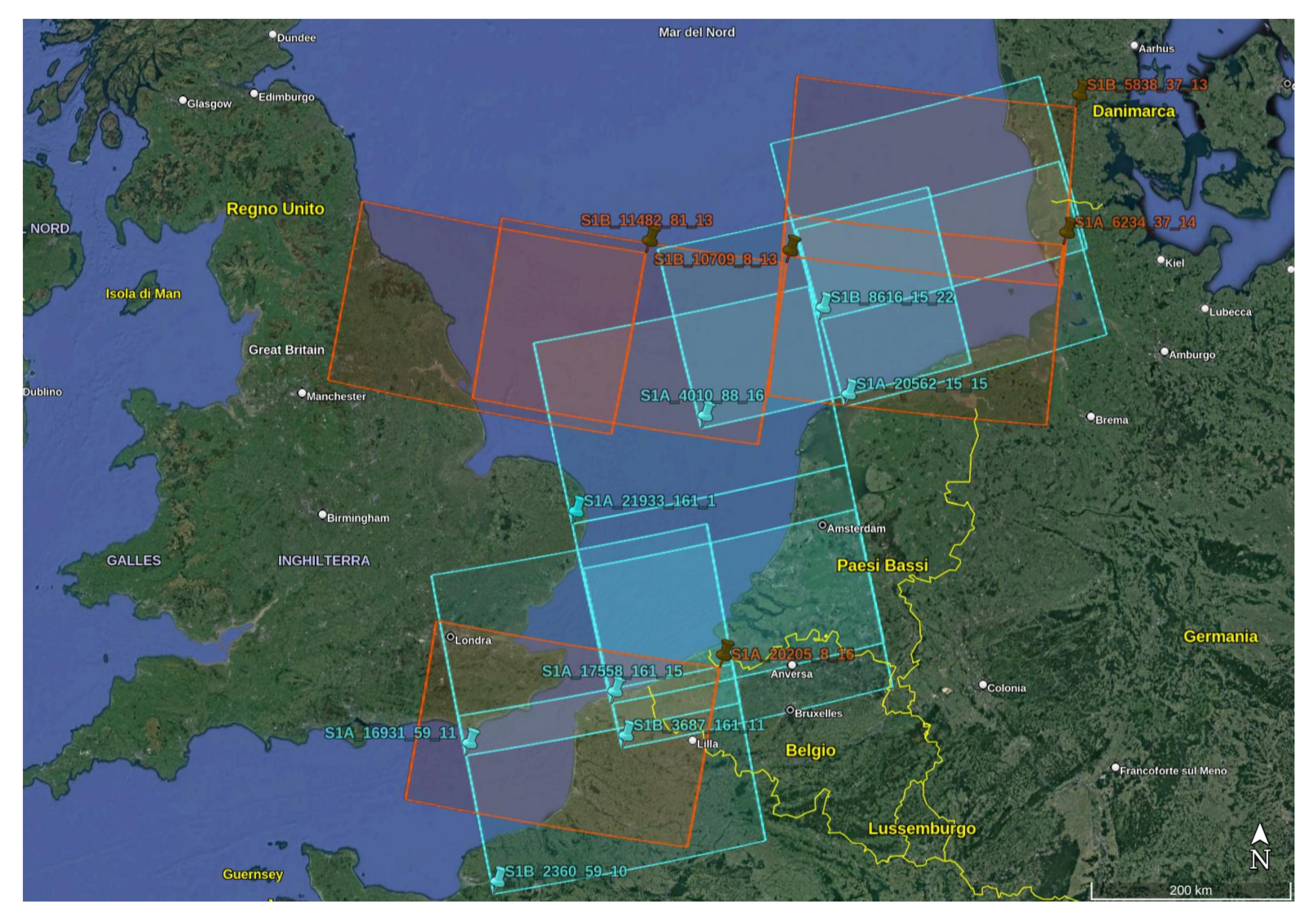
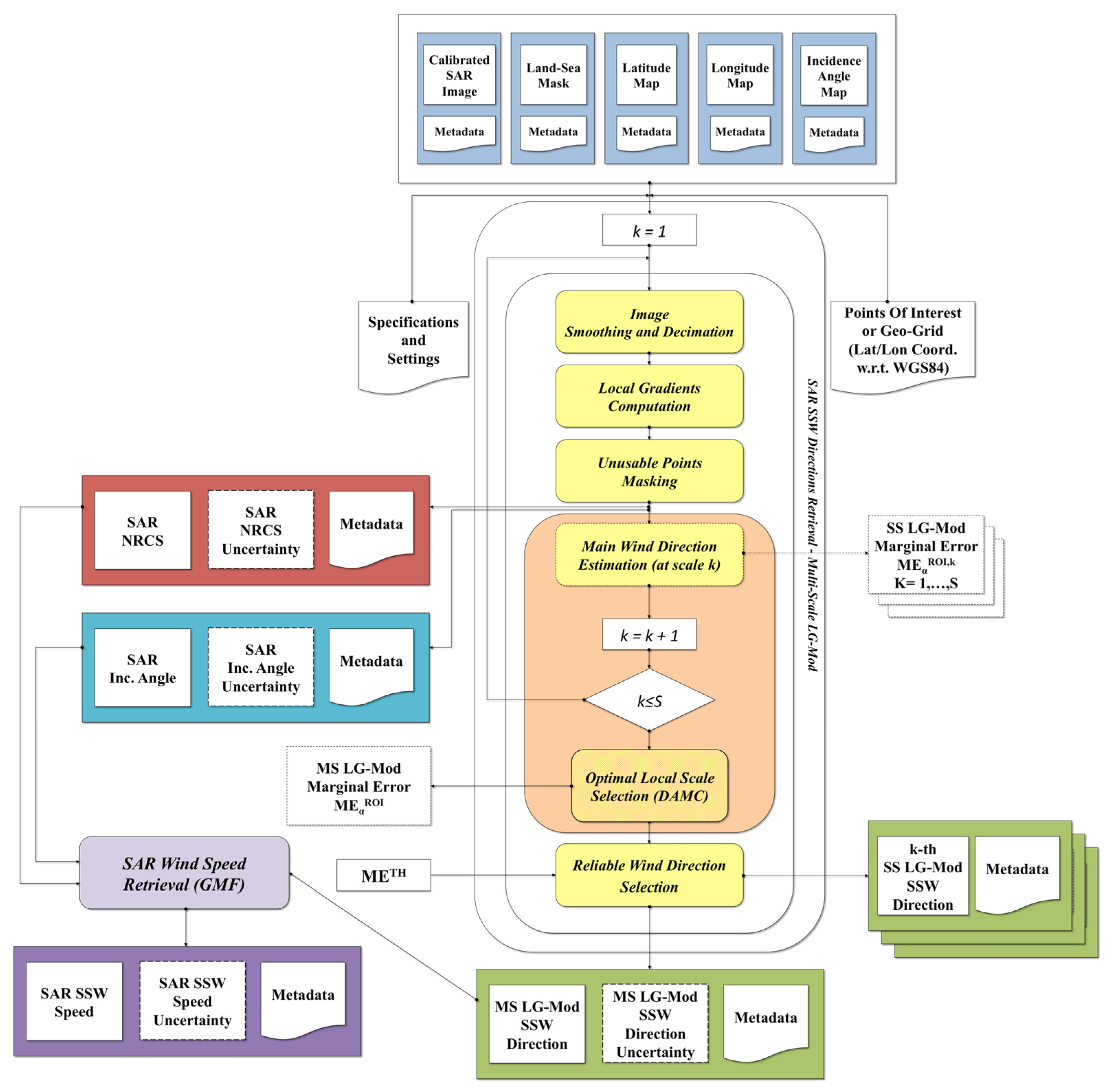
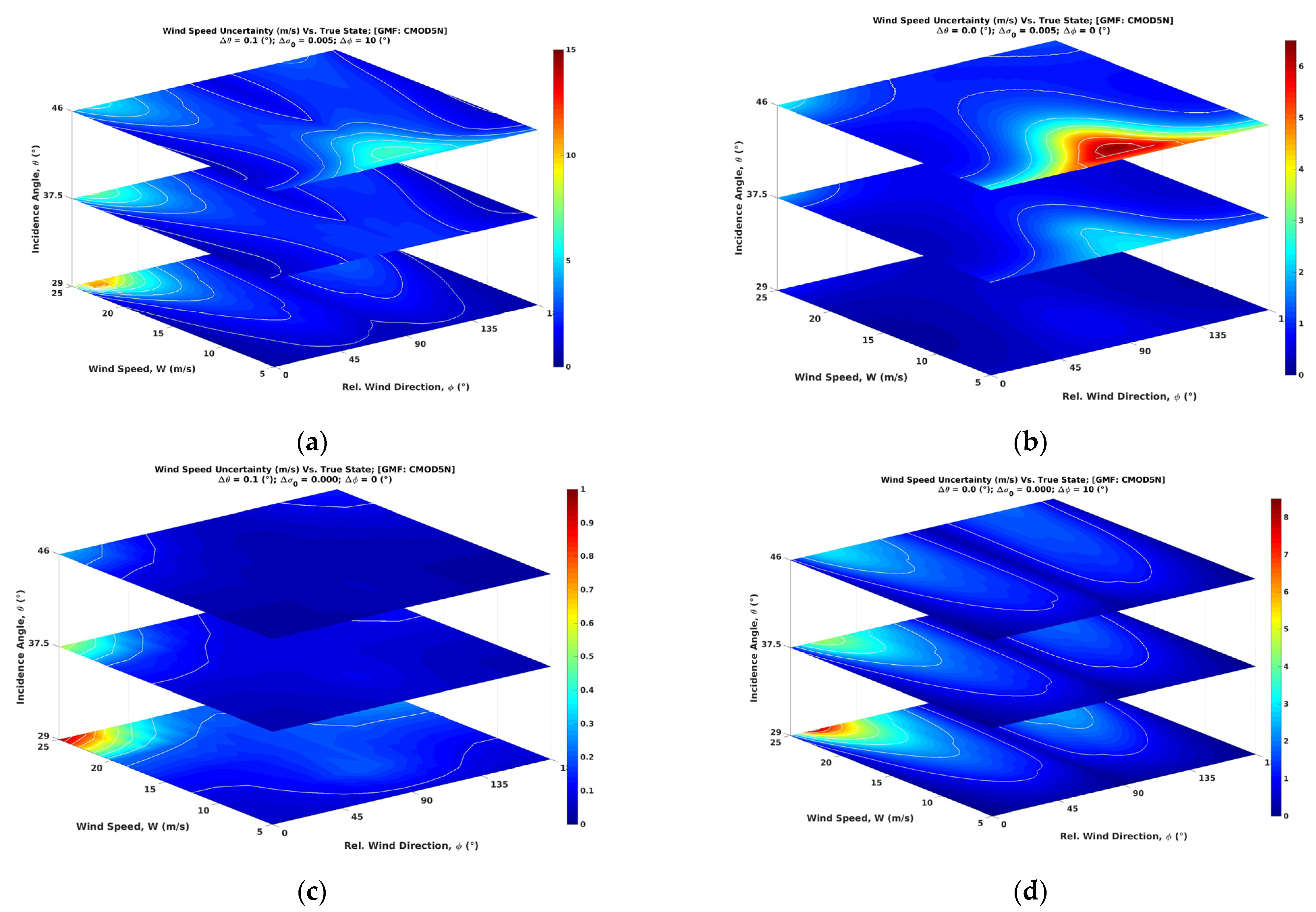

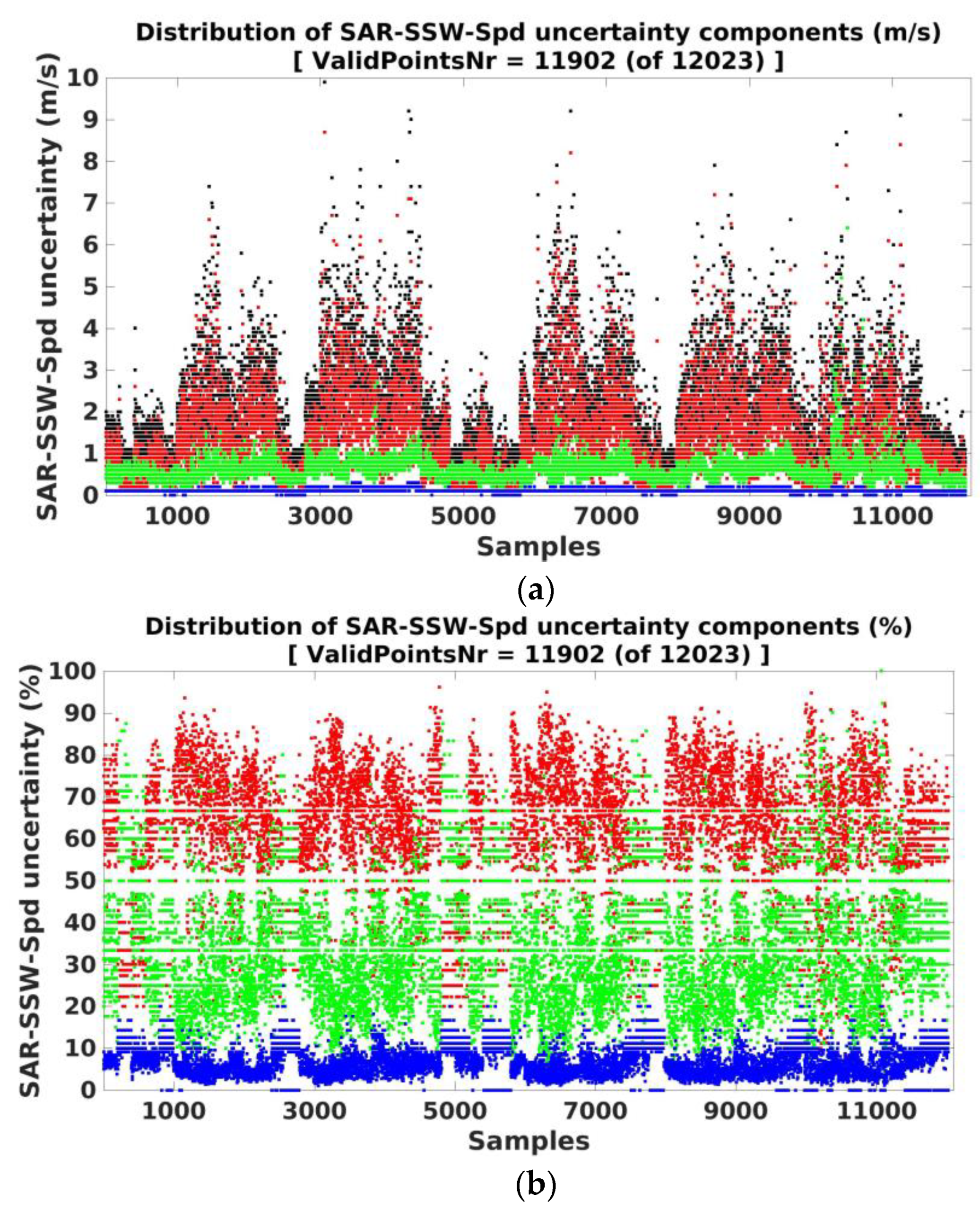
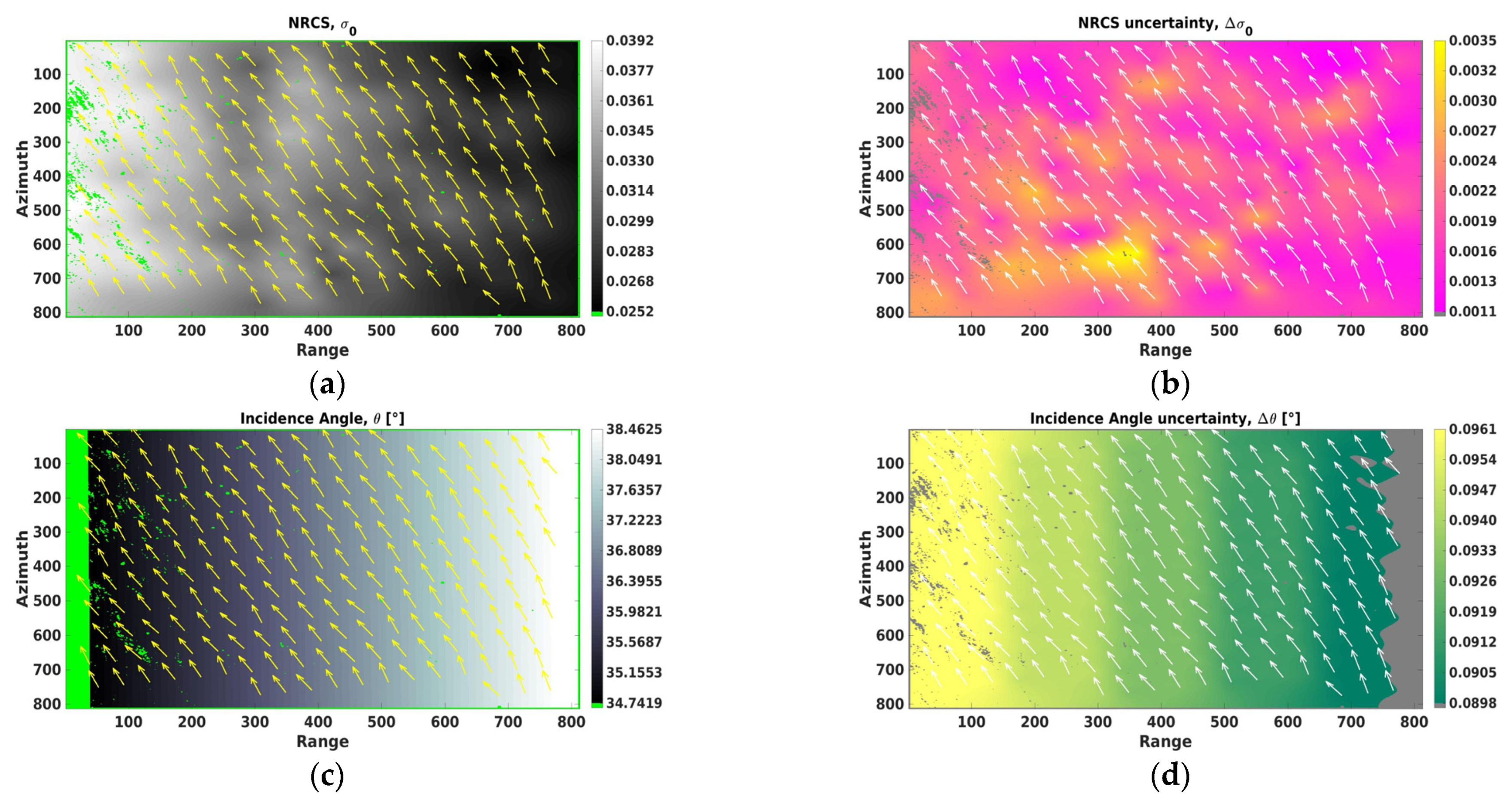


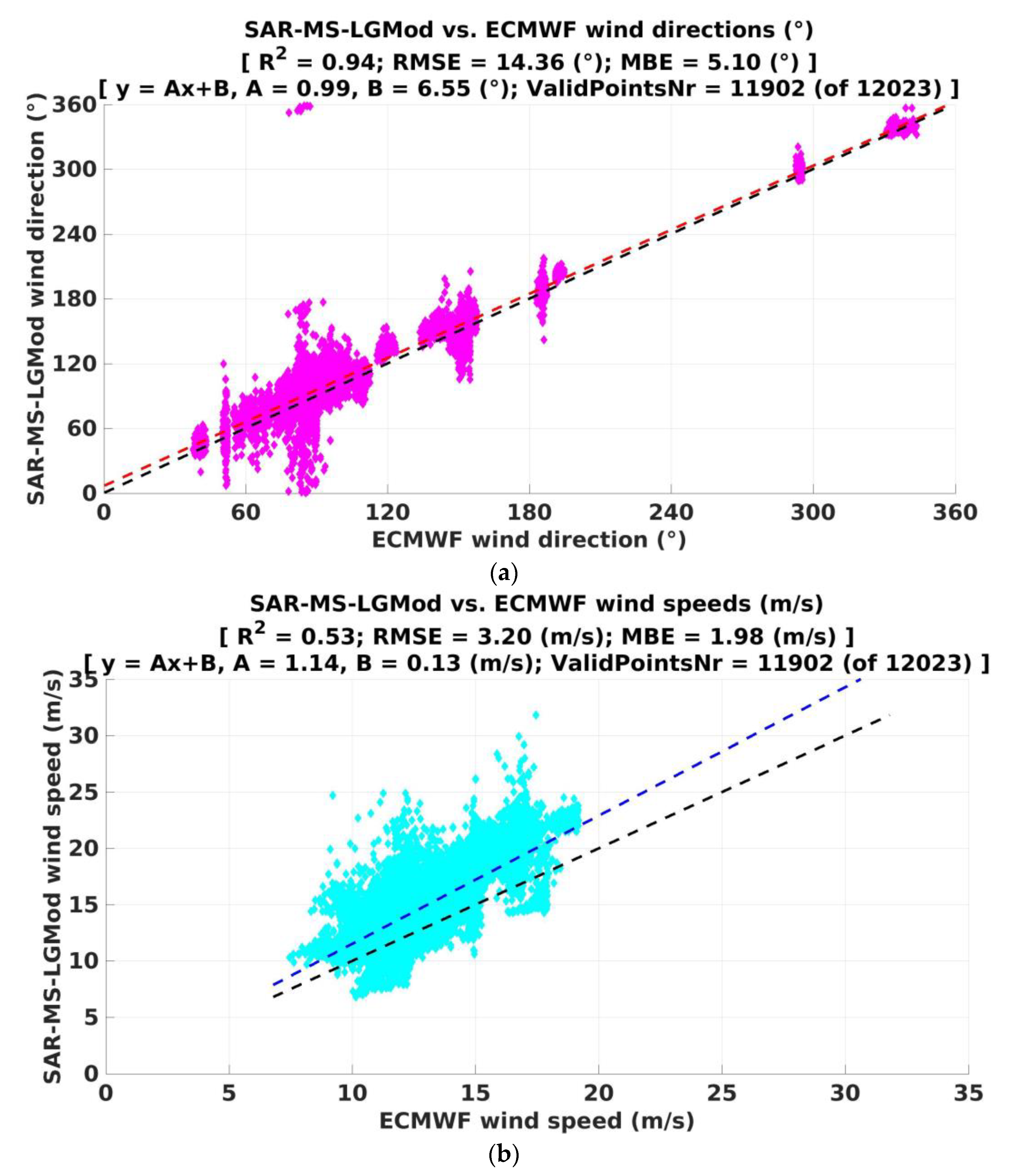
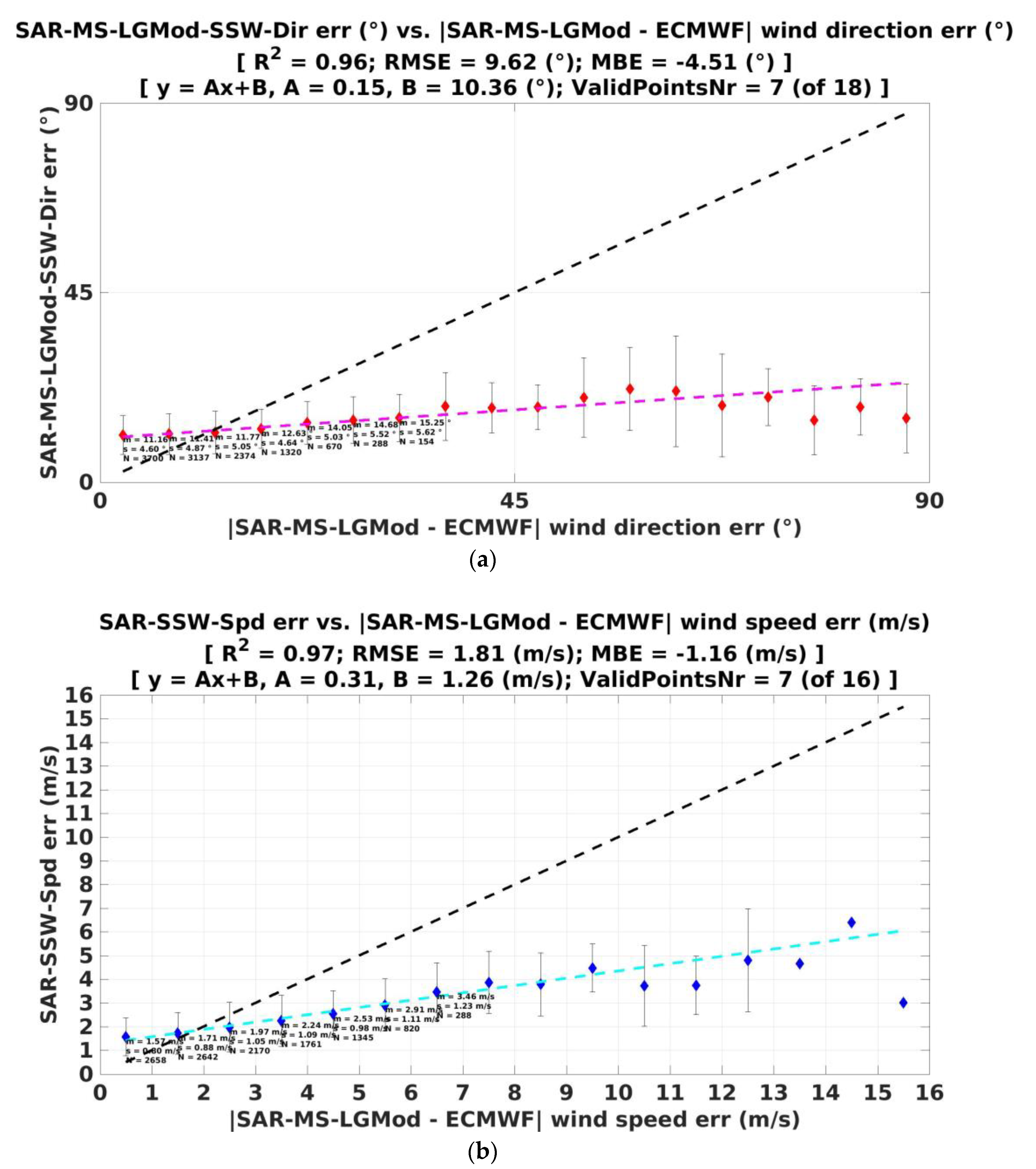
| NRCS | Incidence Angle (°) | MS LG-Mod SSW Relative Direction (°) | |||||||
|---|---|---|---|---|---|---|---|---|---|
| 5 km | 10 km | 15 km | 5 km | 10 km | 15 km | 5 km | 10 km | 15 km | |
| ∀i,…,N_ROI(mA_ROIi) 1 | 0.0165 | 0.0182 | 0.0178 | 31.76 | 32.05 | 32.12 | 74.42 | 92.66 | 81.34 |
| ∀i,…,N_ROI(mA_ROIi) 1 | 0.2887 | 0.2799 | 0.2770 | 45.03 | 44.80 | 44.68 | 282.25 | 269.86 | 267.86 |
| ∀i,…,N_ROI(mA_ROIi) 1 | 0.1020 | 0.1021 | 0.1024 | 37.34 | 37.35 | 37.33 | 184.11 | 184.04 | 184.07 |
| ∀i,…,N _ROI(mA_ROIi) 1 | 0.0531 | 0.0525 | 0.0523 | 2.98 | 2.93 | 2.93 | 1.12 | 2.36 | 3.76 |
| ∀i,…,N _ROI(sA_ROIi) 1 | 0.0009 | 0.0007 | 0.0006 | 0.08 | 0.15 | 0.23 | 3.58 | 2.13 | 1.53 |
| ∀i,…,N _ROI(sA_ROIi) 1 | 0.0482 | 0.0318 | 0.0235 | 0.10 | 0.20 | 0.30 | 90.00 | 42.51 | 15.89 |
| ∀i,…,N _ROI(sA_ROIi) 1 | 0.0056 | 0.0055 | 0.0063 | 0.09 | 0.18 | 0.27 | 12.08 | 6.18 | 4.16 |
| ∀i,…,N _ROI(sA_ROIi) 1 | 0.0029 | 0.0031 | 0.0035 | 0.01 | 0.01 | 0.02 | 5.56 | 2.40 | 1.52 |
| CMOD5.N | CMOD7 | |||||
|---|---|---|---|---|---|---|
| 5 km | 10 km | 15 km | 5 km | 10 km | 15 km | |
| ∀i,…,N_ROI(W_ROIi) (m/s) 1 | 6.8 | 7.2 | 7.5 | 6.6 | 7.1 | 7.4 |
| ∀i,…,N_ROI(W_ROIi) (m/s) 1 | 31.8 | 27.7 | 23 | 30.6 | 26.9 | 22.3 |
| ∀i,…,N_ROI(W_ROIi) (m/s) 1 | 15.31 | 15.22 | 15.20 | 14.84 | 14.74 | 14.73 |
| ∀i,…,N_ROI(W_ROIi) (m/s) 1 | 3.64 | 3.49 | 3.46 | 3.37 | 3.21 | 3.18 |
| ∀i,…,N _ROI(E_ROIi) (m/s) 1 | 0.4 | 0.4 | 0.5 | 0.4 | 0.4 | 0.4 |
| ∀i,…,N_ROI(E_ROIi) (m/s) 1 | 12.7 | 4.7 | 4.4 | 12.2 | 4.8 | 4.2 |
| ∀i,…,N_ROI(E_ROIi) (m/s) 1 | 2.07 | 1.39 | 1.35 | 1.97 | 1.31 | 1.26 |
| ∀i,…,N_ROI(E_ROIi) (m/s) 1 | 1.12 | 0.63 | 0.58 | 1.11 | 0.60 | 0.56 |
| CMOD5.N | CMOD7 | |||||
|---|---|---|---|---|---|---|
| 5 km | 10 km | 15 km | 5 km | 10 km | 15 km | |
| ∀i,…,N_ROI(E1_ROIi) (m/s) 1 | 0.61 (34.63%) | 0.59 (45.43%) | 0.67 (50.66%) | 0.57 (34.52%) | 0.55 (45.23%) | 0.63 (51.03%) |
| ∀i,…,N_ROI(E1_ROIi) (m/s) 1 | 0.27 (14.63%) | 0.28 (13.78%) | 0.31 (12.08%) | 0.25 (14.89%) | 0.26 (14.02%) | 0.29 (12.39%) |
| ∀i,…,N_ROI(E2_ROIi) (m/s) 1 | 0.11 (6.65%) | 0.19 (14.99%) | 0.28 (22.03%) | 0.11 (6.87%) | 0.18 (15.20%) | 0.26 (22.30%) |
| ∀i,…,N_ROI(E2_ROIi) (m/s) 1 | 0.04 (3.47%) | 0.08 (5.96%) | 0.11 (7.66%) | 0.04 (3.77%) | 0.08 (6.13%) | 0.11 (7.86%) |
| ∀i,…,N_ROI(E3_ROIi) (m/s) 1 | 1.34 (59.81%) | 0.62 (41.38%) | 0.42 (29.23%) | 1.29 (59.91%) | 0.59 (41.63%) | 0.39 (29.18%) |
| ∀i,…,N_ROI(E3_ROIi) (m/s) 1 | 0.96 (15.26%) | 0.41 (14.68%) | 0.27 (12.49%) | 0.96 (15.26%) | 0.39 (14.86%) | 0.26 (12.63%) |
| MS LG-Mod SSW Direction (°) | CMOD5.N (m/s) | CMOD7 (m/s) | ||||||||
|---|---|---|---|---|---|---|---|---|---|---|
| Based on | 5 km | 10 km | 15 km | 5 km | 10 km | 15 km | 5 km | 10 km | 15 km | |
| RMSE | SAR uncertainty | 13.30 | 6.63 | 4.43 | 2.35 | 1.53 | 1.47 | 2.26 | 1.44 | 1.38 |
| |SAR–ECMWF| | 14.36 | 11.53 | 10.63 | 3.20 | 2.99 | 2.96 | 2.76 | 2.56 | 2.52 | |
| MS LG-Mod SSW Direction (°) | CMOD5.N (m/s) | CMOD7 (m/s) | |||||||
|---|---|---|---|---|---|---|---|---|---|
| 5 km | 10 km | 15 km | 5 km | 10 km | 15 km | 5 km | 10 km | 15 km | |
| R2 | 0.96 | 0.94 | 0.96 | 0.97 | 0.99 | 0.91 | 0.96 | 0.95 | 0.98 |
| y = Ax + B | |||||||||
| A | 0.15 | 0.07 | 0.03 | 0.31 | 0.14 | 0.11 | 0.35 | 0.14 | 0.10 |
| B | 10.36 | 5.53 | 3.93 | 1.26 | 1.04 | 1.08 | 1.18 | 1.01 | 1.06 |
Publisher’s Note: MDPI stays neutral with regard to jurisdictional claims in published maps and institutional affiliations. |
© 2022 by the authors. Licensee MDPI, Basel, Switzerland. This article is an open access article distributed under the terms and conditions of the Creative Commons Attribution (CC BY) license (https://creativecommons.org/licenses/by/4.0/).
Share and Cite
Rana, F.M.; Adamo, M. Uncertainty Analysis in SAR Sea Surface Wind Speed Retrieval through C-Band Geophysical Model Functions Inversion. Remote Sens. 2022, 14, 1685. https://doi.org/10.3390/rs14071685
Rana FM, Adamo M. Uncertainty Analysis in SAR Sea Surface Wind Speed Retrieval through C-Band Geophysical Model Functions Inversion. Remote Sensing. 2022; 14(7):1685. https://doi.org/10.3390/rs14071685
Chicago/Turabian StyleRana, Fabio Michele, and Maria Adamo. 2022. "Uncertainty Analysis in SAR Sea Surface Wind Speed Retrieval through C-Band Geophysical Model Functions Inversion" Remote Sensing 14, no. 7: 1685. https://doi.org/10.3390/rs14071685
APA StyleRana, F. M., & Adamo, M. (2022). Uncertainty Analysis in SAR Sea Surface Wind Speed Retrieval through C-Band Geophysical Model Functions Inversion. Remote Sensing, 14(7), 1685. https://doi.org/10.3390/rs14071685






